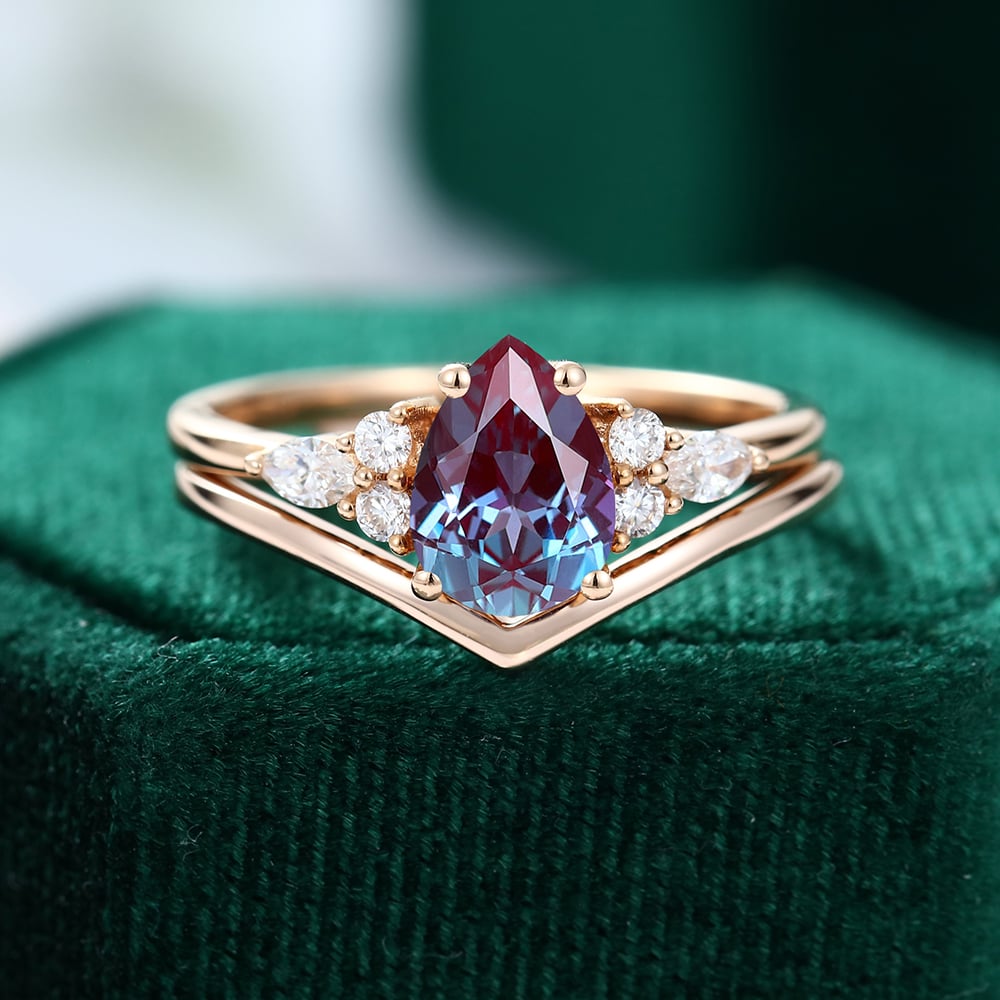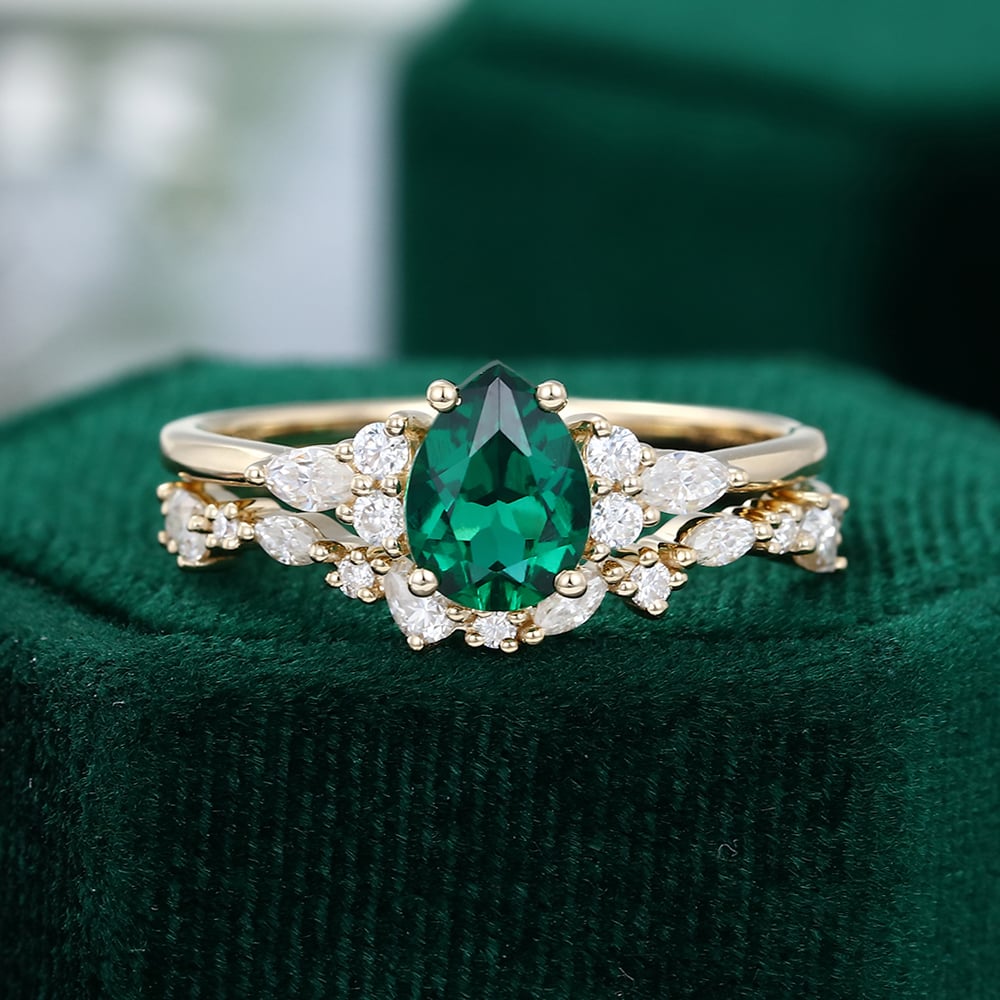Alexandrite and emerald are both beautiful and enchanting gemstones. Since alexandrite is often called “the emerald of the day, the ruby of the night,” comparisons between these two gemstones are inevitable. In this article, we will discuss the differences between alexandrite and emerald.

Table Of Contents
- Alexandrite vs. Emerald In Origin and Discovery
- Alexandrite vs. Emerald In Physical and Chemical Properties
- Alexandrite vs. Emerald In Clarity
- Alexandrite vs. Emerald In Cutting
- Alexandrite vs. Emerald In Symbolism
- Alexandrite vs. Emerald In Price and Rarity
- Alexandrite vs. Emerald In Jewelry Uses
- How TO Care for Alexandrite and Emerald
- FAQs About Alexandrite vs. Emerald
Alexandrite vs. Emerald In Origin and Discovery
Alexandrite: Alexandrite was first discovered in the Ural Mountains of Russia in the 1830s. It is said that Tsar Alexander II noticed this unique gemstone at his birthday party and named it after himself. This gemstone is renowned for its remarkable color-changing ability, appearing green in daylight and pruned under incandescent light. Due to this dichroism, alexandrite sometimes appears on lists of green gemstones. Today, Sri Lanka, East Africa, and Brazil are the main sources of alexandrite. Its unique optical properties make it one of the most sought-after and valuable gemstones in the world.
Emerald: According to records, the first emerald mine was discovered in Ancient Egypt over 4,000 B.C. This gemstone has a long history and has always been treasured. The name “emerald” comes from the Greek word “smaragdus,” meaning green. Today, Colombia, Zambia, and Brazil are the main sources of high-quality emeralds. Emeralds have captivated people with their rich green color and have long symbolized royalty and luxury.
Alexandrite vs. Emerald In Physical and Chemical Properties
| Types | Alexandrite | Emerald |
|---|---|---|
| Color | Green to prune (dichroism) | Green |
| Hardness | 8.5 | 7.5-8 |
| Chemical Formula | BeAl2O4 | Be3Al2(SiO3)6 |
| Crystal System | Orthorhombic | Hexagonal |
Alexandrite: Alexandrite is a type of chrysoberyl with the chemical formula BeAl2O4. It’s harder than emerald, with a Mohs hardness of 8.5, making it suitable for various jewelry. It can produce a range of colors from green to red under different lighting conditions, a unique effect caused by chromium ions in its chemical composition, which absorb and reflect light differently depending on the lighting.
Emerald: Emerald is a type of beryl with the chemical formula Be3Al2(SiO3)6. It is slightly softer than alexandrite, with a Mohs hardness of 7.5-8. Emeralds can produce varying degrees of green, originating from trace amounts of chromium and vanadium. Emeralds typically contain inclusions, which people consider a characteristic part of the gem. When these inclusions form unique patterns, they can increase the emerald’s value.
Alexandrite vs. Emerald In Clarity
Clarity is a key factor in determining the value and beauty of any gemstone. emeralds and alexandrite are famous for their captivating colors, but their clarity characteristics differ significantly.
Alexandrite: Alexandrite tends to have fewer inclusions, possibly because it is extremely rare. Unlike emeralds, some inclusions in alexandrite can increase the gemstone’s value. For example, alexandrite with needle-like inclusions can exhibit a “cat’s eye” effect, enhancing its value, although such inclusions are rare. Generally, alexandrites with fewer inclusions and higher clarity are more valuable. In the industry, some methods treat the inclusions in alexandrite, but people do not accept this practice.
Emerald: Emeralds inherit the naturally fissured characteristics of the beryl family, making completely clear emeralds extremely rare. The cracks and tiny crystal inclusions inside emeralds are often referred to as “le jardín” (French for “the garden”) and are considered part of their charm. Although inclusions are part of emeralds’ allure, they affect the gemstone’s clarity and value. Therefore, most emeralds undergo “oil treatment” (injecting oil into the fissures under vacuum conditions) to improve clarity, a widely accepted practice in the industry.
Alexandrite vs. Emerald In Cutting
Proper cutting can showcase the best aspects of a gemstone. emerald and alexandrite have different crystal structures, hardness, and clarity characteristics, necessitating different cutting styles.
Alexandrite: Due to its higher hardness and clarity, alexandrite is not as limited in cutting styles. Jewelers most commonly use the oval cut, which highlights alexandrite’s color changes while enhancing its luster. If you are looking for a brighter, more sparkling effect, choose the round brilliant cut, which maximizes the fire and luster of the gemstone, but which may interfere with the display of color change due to its high brilliance.
Emerald: Emeralds typically have more inclusions, so choosing a cutting style is crucial to showcase their unique beauty. The step cut, especially the emerald cut (Originally designed for emeralds.), is the most suitable for emeralds. The step cut retains the maximum weight of the gemstone, increases the depth of the green color, and disperses light to make inclusions less noticeable. It also perfectly displays the unique “le jardin” effect when viewed from the front.
Alexandrite vs. Emerald In Symbolism
Alexandrite: Alexandrite’s color-changing property symbolizes harmony and duality, transformation, and adaptability. In Russia, people consider it the national stone and believe it brings good luck and fortune. Additionally, alexandrite is one of the birthstones for June and the gemstone for the 55th wedding anniversary.
Emerald: Green emeralds are often associated with spring, symbolizing rebirth, growth, vitality, love, and prosperity, making them popular for engagement rings and high-end jewelry. Emerald is also the birthstone for May and the gemstone for the 20th and 35th wedding anniversaries.
Alexandrite vs. Emerald In Price and Rarity
Alexandrite: Natural alexandrite is extremely rare and can be more expensive than diamonds of the same size. The value of alexandrite primarily depends on the intensity of its color change, clarity, and carat weight. High-quality alexandrite with a pronounced color change and minimal inclusions can fetch prices exceeding $15,000 per carat.
Emerald: Emeralds are also rare, but their value is influenced by color, clarity, and origin. Colombian emeralds are renowned for their deep green hue and are among the most valuable. Unlike alexandrite, inclusions in emeralds (called “le jardín”) are common and considered characteristic. High-quality emerald prices can range from $1,000 to $100,000 per carat, depending on quality and origin.
Alexandrite vs. Emerald In Jewelry Uses
Alexandrite: Alexandrite’s unique color-changing property makes it a captivating choice for various jewelry, including rings, earrings, and pendants. Its hardness makes it suitable for everyday wear. It is often set in gold or platinum to enhance its beauty and highlight its color change effect.
Natural alexandrite jewelry is not only expensive but extremely rare, so to own this beautiful gemstone, consider buying lab alexandrite jewelry.
Emerald: Emeralds are a classic choice for fine jewelry, commonly used in rings, necklaces, bracelets, and earrings, with emerald engagement rings and emerald pendant necklaces are popular for their large vivid green emeralds. Due to their relative softness, emeralds are often set in protective settings to prevent damage.
Alexandrite Ring vs. Emerald Ring
Alexandrite Necklace vs. Emerald Necklace
How TO Care for Alexandrite and Emerald
Alexandrite: Due to its high hardness, alexandrite is relatively easy to care for. It can be cleaned with mild soapy water and a soft brush. Ultrasonic cleaners are generally safe for alexandrite, but steam cleaning should be avoided as it can cause thermal shock and damage the gemstone.
Emerald: Emeralds require more delicate care due to their inclusions and potential treatments. They should be cleaned with mild soapy water and a soft brush, avoiding ultrasonic and steam cleaners. Regular checks by a professional jeweler are recommended to ensure that any treatments remain effective and that the gemstone is securely set.
Final Thoughts
Both alexandrite and emerald are extraordinary gemstones with unique characteristics and historical significance. Alexandrite’s mesmerizing color change and rarity make it a magical and captivating gemstone, while emerald’s rich green hues and legendary history bestow it with timeless elegance and allure. Whether you are drawn to alexandrite’s mystery or emerald’s classic beauty, both gemstones offer unparalleled beauty and value, making them precious additions to any jewelry collection. Get high-quality, affordable lab alexandrite jewelry and lab emerald jewelry at MollyJewelryUS.
FAQs About Alexandrite vs. Emerald
Which is more expensive, alexandrite vs. emerald?
Generally, alexandrite is more expensive due to its rarity.
Which is more durable, alexandrite or emerald?
Alexandrite is more durable, with a Mohs hardness of 8.5 compared to emerald’s 7.5-8.
Which is rarer, alexandrite vs. emerald?
High-quality alexandrite and emerald are both rare, but alexandrite is rarer in the market.
Which is better for collecting, alexandrite or emerald?
High-quality natural alexandrite has extremely high collectible value, while emeralds, as traditional gemstones, have always been favored by collectors.
How to tell alexandrite from emerald?
Alexandrite exhibits different colors under different lighting, while emerald always maintains a green base color.
Which is more suitable for daily wear, alexandrite or emerald?
Both are suitable for daily wear. If comparing based on hardness, alexandrite is the better choice.



